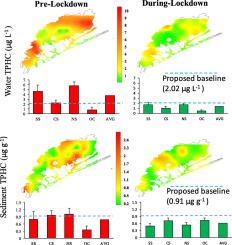Marine Pollution Bulletin ( IF 5.3 ) Pub Date : 2021-12-01 , DOI: 10.1016/j.marpolbul.2021.113137 Prasannajit Acharya 1 , Pradipta R Muduli 2 , Deepak R Mishra 3 , Abhishek Kumar 4 , Vishnu Vardhan Kanuri 5 , Mira Das 6

|
India successfully executed one of the strictest lockdowns in the world during the height of the COVID-19 pandemic in early 2020, which provided unique opportunities to analyze the second-largest populous country's anthropogenic footprint on its natural systems. India's first Ramsar site and the world's second-largest brackish water system Chilika lagoon experienced a substantial decline (64%) in the total petroleum hydrocarbon (TPHC) level in water, which was attributed to the massive declines or, at times, an abrupt complete halt of motorized boat operations for fishing and tourism. Using the TPHC values during the lockdown period, our study recommends a TPHC baseline threshold of 2.02 μg L−1 and 0.91 μg g−1 for Chilika waters and sediment, respectively. These baseline values can be used to quantify oil pollution and to formulate policy and management action plans for Chilika lagoon as well as for other similar ecosystems by local environmental agencies.
中文翻译:

COVID-19 封锁对亚洲最大咸水泻湖石油烃总量的影响
印度在 2020 年初 COVID-19 大流行高峰期间成功实施了世界上最严格的封锁措施之一,这为分析这个第二大人口大国对其自然系统的人为足迹提供了独特的机会。印度第一个拉姆萨尔湿地和世界第二大咸水系统 Chilika 泻湖经历了水中总石油烃 (TPHC) 水平的大幅下降 (64%),这归因于大幅下降或有时突然完全下降停止用于捕鱼和旅游的机动船作业。使用锁定期间的 TPHC 值,我们的研究建议 TPHC 基线阈值为 2.02 μg L −1和 0.91 μg g −1分别用于 Chilika 水域和沉积物。这些基线值可用于量化石油污染,并由当地环境机构为 Chilika 泻湖以及其他类似生态系统制定政策和管理行动计划。











































 京公网安备 11010802027423号
京公网安备 11010802027423号